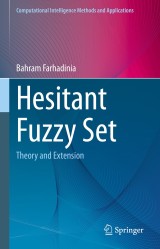Details

Hesitant Fuzzy Set
Theory and ExtensionComputational Intelligence Methods and Applications
|
128,39 € |
|
| Verlag: | Springer |
| Format: | |
| Veröffentl.: | 04.12.2021 |
| ISBN/EAN: | 9789811673016 |
| Sprache: | englisch |
| Anzahl Seiten: | 151 |
Dieses eBook enthält ein Wasserzeichen.
Beschreibungen
<div>Covering a wide range of notions concerning hesitant fuzzy set and its extensions, this book provides a comprehensive reference to the topic. In the case where different sources of vagueness appear simultaneously, the concept of fuzzy set is not able to properly model the uncertainty, imprecise and vague information. In order to overcome such a limitation, different types of fuzzy extension have been introduced so far. Among them, hesitant fuzzy set was first introduced in 2010, and the existing extensions of hesitant fuzzy set have been encountering an increasing interest and attracting more and more attentions up to now. It is not an exaggeration to say that the recent decade has seen the blossoming of a larger set of techniques and theoretical outcomes for hesitant fuzzy set together with its extensions as well as applications.</div>As the research has moved beyond its infancy, and now it is entering a maturing phase with increased numbers and types of extensions, this book aims to give a comprehensive review of such researches. Presenting the review of many and important types of hesitant fuzzy extensions, and including references to a large number of related publications, this book will serve as a useful reference book for researchers in this field.
Chapter 1: Hesitant Fuzzy Set.- Chapter 2: Hesitant Fuzzy Linguistic Term Set.- Chapter 3: Neutrosophic Hesitant Fuzzy Set.- Chapter 4: Pythagorean Hesitant Fuzzy Set.- Chapter 5: q-Rung Orthopair Hesitant Fuzzy Set.- Chapter 6: Probabilistic Hesitant Fuzzy Set.- Chapter 7: Type 2 Hesitant Fuzzy Set.- Chapter 8: Hesitant Bipolar Fuzzy Set.- Chapter 9: Cubic Hesitant Fuzzy Set.- Chapter 10: Complex Hesitant Fuzzy Set.- Chapter 11: Picture Hesitant Fuzzy Set.- Chapter 12: Spherical Hesitant Fuzzy Set.
Bahram Farhadinia is a full professor of applied mathematics at Quchan University of Technology, Iran. He ranked in Stanford study of the world's top 2% of scientists in 2020, in the Islamic World Science Citation Center (ISC) of the ISC's top 1% of scientists in 2019 and 2020. He has published the book <i>Information Measures for Hesitant Fuzzy Sets and Their Extensions</i>, Springer 2019, 2 Persian books, and more than 70 peer-reviewed papers, many of them in high-quality international journals. His current research interest includes artificial intelligence and multiple criteria decision-making under uncertainty. He has received numerous honors and awards, including the 2001 and 2005 Outstanding Graduate awards, Distinguished Researcher Award (QUT 2011, 2013–2020), among others. He is the deputy of Iranian Fuzzy Systems Society and the editor of <i>CAAI Transections on Intelligence Technology</i>, <i>Frontier in Artificial Intelligence Fuzzy Systems</i>, and <i>International Computer Science and Engineering Society</i>.
<div>Covering a wide range of notions concerning hesitant fuzzy set and its extensions, this book provides a comprehensive reference to the topic. In the case where different sources of vagueness appear simultaneously, the concept of fuzzy set is not able to properly model the uncertainty, imprecise and vague information. In order to overcome such a limitation, different types of fuzzy extension have been introduced so far. Among them, hesitant fuzzy set was first introduced in 2010, and the existing extensions of hesitant fuzzy set have been encountering an increasing interest and attracting more and more attentions up to now. It is not an exaggeration to say that the recent decade has seen the blossoming of a larger set of techniques and theoretical outcomes for hesitant fuzzy set together with its extensions as well as applications.</div><div>As the research has moved beyond its infancy, and now it is entering a maturing phase with increased numbers and types of extensions, this book aims to give a comprehensive review of such researches. Presenting the review of many and important types of hesitant fuzzy extensions, and including references to a large number of related publications, this book will serve as a useful reference book for researchers in this field.</div>
Provides a comprehensive review and update on hesitant fuzzy extensions Written in a unified framework for a better understanding of the topic Ranging from theories, methodologies/algorithms, to various applications
Diese Produkte könnten Sie auch interessieren:

Automatización Eficiente. Transformando la gestión de datos por medio de Microsoft Access

von: Damir-Nester Saedeq

13,99 €















